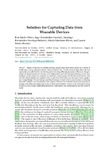Solution for Capturing Data from Wearable Devices

Use this link to cite
http://hdl.handle.net/2183/34110
Except where otherwise noted, this item's license is described as Attribution 4.0 International (CC BY 4.0)
Metadata
Show full item recordTitle
Solution for Capturing Data from Wearable DevicesAuthor(s)
Date
2023Abstract
[Abstract] Thanks to the rise of wearable devices, people have more direct access to a variety of
health data, such as physical activity, sleep and heart rate. For the research field, these devices
represent a powerful tool for monitoring and evaluating different parameters. However, the procedure
of capturing data for storage in an independent and self-managed database is not standardised.
In this project we analysed two methods of data capture for the Xiaomi Mi Bands. One
uses the official application together with Google Fit and the other uses the open source application
GadgetBridge. The advantages and disadvantages of each system were studied, concluding
that both could be very beneficial as data capture solutions for wearable devices in research, although
with different target projects due to their particularities. Future work will explore these
systems in more depth, addressing limitations, automation and optimising for specific research
needs
Keywords
Captura de datos
Datos de salud
Xiaomi mi band
Google Fit
Datos de salud
Xiaomi mi band
Google Fit
Description
Cursos e Congresos , C-155
Editor version
Rights
Attribution 4.0 International (CC BY 4.0)






